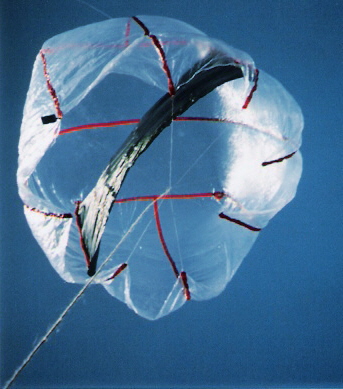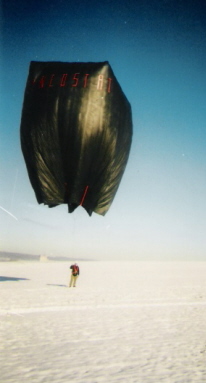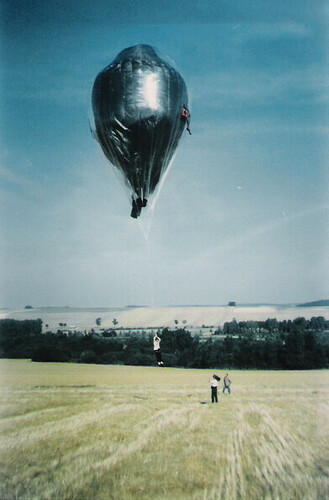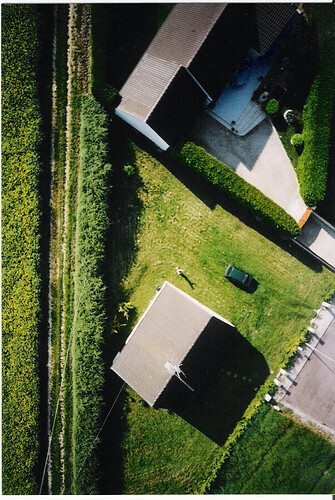Maybe the solar hot-air systems could utilize coal to stay aloft at night. This would generate CO2, which would help plants grow better, thereby greening the Earth! ![]()
I was of that opinion initially but now I’m not sure. Did you find some numbers worse than mine?
We have some options: During daylight one could have propulsion to survive lulls. Also fly fig8 to increase lift through apparent wind speed.
The only really big question for me is if a 300x30 kite is worth maintaining for 1 MW peak power…
In my opinion, the elevation angle must be high, which does not facilitate things and imposes a lot of aerodynamic and probably aerostatic lift.
This is the problem with AWES or ASWES: the higher you go, the more resources there are (more sunshine, stronger winds), and the harder it is to exploit them.
I don’t see length of wire in the chart, which seems relevant.
Another try, to calculate the resistance R, you need to know the Electrical resistivity and conductivity - Wikipedia of the material \rho . For copper let’s use 1.7 \cdot 10^{-8} (Ω·m), and area A and length l.
R = \rho \dfrac{l}{A} => 1.7 \cdot 10^{-8} \dfrac{8000}{5 \cdot 10^{-5}} = 2.72\ \Omega
You need the R to calculate the voltage drop:
Since the R formula already had the L in there, maybe this is correct: 2 \cdot I \cdot R . Maybe not.
V_{drop} = 2 \cdot 500 \cdot 2.72 = 2720\ V.
If you want a voltage drop of less than 3 percent, that’s too high.
Change area to 500 mm^2 and current to 120 A (10kV +20% current margin) to get 2 \cdot 120 \cdot 0.272 =65.28.
\frac{65.28}{10000} \cdot 100 = 0.65 \% voltage drop. That’s too low.
Change area to 500 mm^2 and current to 500 A to get 2 \cdot 500 \cdot 0.272 =272.
\frac{272}{8000} \cdot 100 = 3.4 \% voltage drop. That’s about right, but the area and current are wrong.
Another page: Find the Right Size of Wire & Cable for Metric & Imperial Systems
I think high altitude winds still are sometimes zero, sometimes very high. Because you need to do something during lulls you are in a pickle. For 8 km tether, if you reel in pretty fast at 10 m/s that takes 13-14 minutes of time, every time also energy expenditure in this phase will be high. Reel out can not be done as fast and only when ground wind is high enough. So lets say wind is 12 m/s and you reel out at 5 m/s (pretty fast IMHO) you need almost half an hour to deploy the system.
Another idea: multiple kytoon yoyo / spidermill. Maybe you’d add insulation and solar panels to continuously heat them up… This would perhaps benefit from a reverse scaling effect, the kytoons retaining heat better and becoming more buoyant the larger they get.
Maybe here hydrogen works better than solar, you could add a hydrogen ballonet inside the kytoon, but you’d need to make a strong case that your escaped hydrogen isn’t exacerbating the problem, global warming, you’re trying to mitigate. It adds significant cost and complexity anyway.
In my previous comment I still ignored required insulation and what happens when the cable is wrapped around the drum in the hot summer while the solar panels are already producing electricity, which is the best, or worst, case you need to design your system for. Also there is the difference in lift between cold and warm weather, in winter you’d need smaller kytoons and cables than in summer but you need to design your system for the worst/best conditions.
I’m thinking maybe that very long and heavy tether is a major impediment, and the idea of going miles into the sky to get above the clouds might not be worth dealing with miles of super-heavy tether. I think it would have a better chance of being economical at much lower heights.
Yes, and we can verify it live on the Global Wind Map. Even high altitude winds are not predictable. It is the reason why balloons inflated with hydrogen or helium are essential for this project, as the author foresees.
I put again the link for the 60 g / m² and 2000 w / kg solar e-film. In spite of its lower efficiency (10-13 % instead of 25 % for heavy solar panels (PV)) its power density is far higher than other PV, so this e-film should replace the initial PV.
By a rough calculation, by taking some numbers that are evoked in this topic (although I don’t know if they are right) and for 1 MW device: electrified tether 20 tons, e-film and electronics 1 ton, balloon 25 tons (huge volume), other equipment, total about 50 tons: about 100 000 m³ (at ground level, and more at high altitude, see below) hydrogen or helium would be required if we want keep a correct elevation angle. That would be almost impossible.
And also, hydrogen leaks are not good for global warming.
The volume of gas is estimated at ground level. Indeed the gas expands strongly as it gains altitude, as shown below (in French but pictures speak for themselves):
And since very strong winds can occur at very high altitude and constitute forces tending to lay the assembly towards the horizontal, a huge lifting kite or a lifting kite train would be necessary to stabilize the angle of elevation. The kite(s) would be located far (to avoid overshadowing it) above the balloon.
I often mentioned kytoons, but the kite side could generate shadow on the balloon including the e-film.
If a (thermal) solar balloon is used, at ground level the aerostatic gain is about 1/10 that of hydrogen or helium.So, if I am not too wrong, the volume would be 10x more. That said, a thermal solar balloon falls or goes down at night, unlike a hydrogen inflated balloon.
An interesting point: the e-film mentioned above is almost black, such as it could also generate thermal energy heating the balloon. It could be installed as a second internal envelope like:
In this eventuality the orientation to the sun is not required, and the implementation of an additional kite is easy, being far above the balloon as mentioned for a gas inflated balloon.
Or the e-film could form the diametrical wall of a transparent balloon like this:

In this case the orientation to the sun is required, and the implementation of an additional kite is not easy.
Even the e-film could constitute a single envelope black balloon like this:

But the problem becomes higher losses by convection (and also by radiation) with the wind, the hot black e-film being directly in contact to the wind. At least the wind will cool the e-film which will have a slightly better performance…
To be clear a thermal solar balloon would not be suitable at high altitude (low efficiency, night, orientation). But things can be different if the solar thermal photovoltaic balloon is implemented close to the ground, and only to free the ground.
Indeed making not airborne cylindrical transparent envelopes with a diametrical e-film wall (like on a photo above, but here the balloon would be closed (?)) on the horizontal seems possible: between two telescopic poles assuring the rotation of the cylinder by the two ends, and also by the elevation of one or the other pole.
An airborne ASWES flying at low altitude (but higher than the device on poles) would have a double envelope (like on a photo above), removing the requirement of orientation to the sun, and would be spherical-shaped. A lifting kite would be implemented far (to avoid overshadowing it) above the balloon, as for the high altitude device mentioned in first.
Just so the group is aware of who has actual skin in these balloon jumping game pictures…
@PierreB
Is that you in those picture above?
@Rodread : I built all these balloons.
On the first photo, you can see the double envelope balloon that lifts me a few meters. This was made a long time ago during a television shooting (it was on the 5 and M6 in France), we see the cameraman with his camera.
On the second photo, you see a photo camera with which I photographed my house:
On the third photo, we see a single black envelope balloon, and my neighbor below. The snow significantly increased the lift by the reflection of the solar radiation in addition to the direct radiation.
These experiments were carried out with little or no wind: during the television filming, the crew followed me by walking while I alternated bouncing (while the rope was taut) and walking (while the balloon went up to finally tighten the rope).
Pierre: That is amazing - you used only solar hot air and got off the ground? I think you are lucky that you did not get into a thermal updraft. They can be very powerful and take you away! ![]()
Yes. I also have videos of the TV show, but I can’t make them public.
Certainly there can be a danger, but I had some margin. The aerostatic thrust of the balloon was only a quarter of my weight. This is explained on
OK that is reassuring.
Still, if you get a thermal, good luck.
We watched chunks of foam orbiting in a dust-devil near here the other day.
It didn’t take long before the chunks of foam were orbiting a quarter-mile high and still rising. I found a few chunks in my yard a few days later.
We also lost a radio-controlled model airplane one day when I zoomed it out of my garage and up into the sky. As we watched it go up, it started doing aerobatics on its own, with my girlfriend complimenting my “flying ability”. I told her “It’s not me, it’s doing it by itself”. It kept going up until we couldn’t see it anymore, and we never found it - right over my house.
The limited controls were only two propellers for power and steering, no elevator or aileron controls - it went up really fast. Thermals are greatly underestimated here in the desert. Hang gliders can get up to 16,000 feet and higher very quickly just riding thermals. Of course you usually have to find a thermal, but sometimes they can find you! ![]()
Pierre I was curious as to whether you included an elastic section on the rope you hung from?
In our regions there is little chance of finding thermals in the morning. This is why hot air balloons fly in the morning and evening, not in the middle of the day, especially in summer.
That said for the TV (there were two films, one with the double envelope, and one other with a single black envelope) I built a far bigger balloon. Someone else used it for the 2nd TV show, and I asked him to use a second rope attached to a second person: that’s what you see on the movie. The jumps were 10 m high, the margin was much smaller, and the mountainous terrain was more conducive to thermals.
Having said that, I have not used this solar balloon for a very long time. But sometimes I see copies…
No, an elastic rope is of no use. Some models have a spiral cord (like a dog leash), but it is only to avoid catching your feet.
OK, good that you knew that about time of day and time of year - how high the sun is.
You and the Montgolfier Brothers, eh?
Thankfully there’s loads of resources to pick from
Not the vid but the science paper.
A bit more clarity if you wish to build e-skins? You can also bear this in mind for cables and harnesses designs. Come to think about it? Electrostatic could also play it part. If I recall my radio theory right? The longer the wire is the better it’s reception. The more wavelength it can interact with. Which is more electrical signals. This was due to the amount of surface area present along the wire. Like the old television Ariels where 16ft of wire would get your most local tv station. I’d had a thunk about it can the balloons create it own internal convection? Hot side and cold side then you have an airborne indifference engine/ airborne Sterling engine. My thinking is as so, but correct me if I’m wrong? Hot air rises, once that reaches the top of the ballon it can be forced back down the wall of the ballon cooling as it goes. Which set up a convection current inside the ballon. Provide there enough convection between top and bottom you can generate electricity. The quickest way I can think of making such a ballon world be black plastic bag and computer fans. To check for internal convection, if that works then you could away mount a Sterling engine upside down to prove it generates electricity. Plenty to consider? As awes has an avid balloonist in @PierreB who better to give it a go?
Too many unexplored assumptions in this topic, the best height of deployment given cloud height and wind and other factors, the need or not for electric cables, the weight of those cables, the need for kytoons, the cost and durability of components, the size and weight and lift of any system, comparison to alternatives, possible use cases, possible niches and locations, and so on.
Compared to this I like other things much better, but this analysis so far is too basic to be of much use to anyone seriously considering this.
Something that you can look into now is cloud cover at different altitudes and at different locations and seasons. Maybe there are locations that consistently have thick low level clouds during some months of the year and little consistent wind. That looks like a question for a meteorology forum like https://earthscience.stackexchange.com/ or maybe https://www.reddit.com/r/meteorology/ A better understanding of that would also be more widely useful.
This topic mainly starts from the study mentioned in the initial post:
In some way this device can be seen as an airborne solar energy system (ASES).
Then other lighter options were studied like the opportunity to implement lighter e-fim.
Some calculations from @tallakt and me shown the difficulty or impossibility to implement such systems with the very long and heavy cables.
That said it is obvious than the cable could be shorter in sunny regions.
And some possibilities at low altitudes were also mentioned.
This is not a topic about meteorology as such, but about airborne solar energy, in addition or not to wind. Links toward reddit-meteorology topics could perhaps bring some additional information, but there are not in the heart of the subject.
That is not a study, it’s a shower thought with pretty pictures.
I did some incomplete calculations. You can’t try to design a system, or know how heavy a cable will be, if you don’t know the most basic things about designing a cable, which knowledge none of us in this thread demonstrated yet.
It is. Maybe most clouds are below 1000 meters, you’d be silly to design a system that flies at 6 kilometers then. You can’t design something if you don’t know the constraints.

